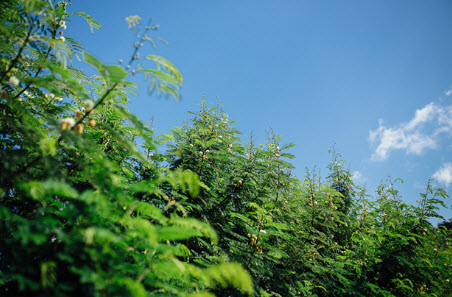Sterile leucaena project underway
17 August 2017

Meat & Livestock Australia is investing in work to develop a sterile variety of the forage legume leucaena.
Leucaena is a fast-growing tropical perennial tree that can be one of the most productive feedbase options for northern cattle producers.
Sterility is not typically a desired trait in the red meat industry, but when applied to leucaena it may prove integral in driving higher beef productivity across Australia’s top end.
It is already used extensively across Queensland, but is currently prohibited from being cultivated on WA crown land because of the risk it posed in becoming an environmental weed.
Meat & Livestock Australia (MLA) – Grassfed Beef R&D manager, Nigel Tomkins, said while development of a sterile, highly nutritious leucaena variety had not previously been tried, it was considered crucial to expansion of the northern pastoral industry.
“In Queensland, it is planted across more than 200,000 hectares and estimated to have boosted liveweight gain by 50,000 tonnes per year, worth an extra $100 million to that State’s beef industry,” he said.
“Research and experience in Queensland has found it is well adapted to clay soils, drought tolerant, persistent (often lasting more than 30 years) and efficiently fixes atmospheric nitrogen to the soil.”
Dr Tomkins said the MLA Donor Company (MDC) would co-invest $2.3 million over the next 3 years with WA Government and the University of Queensland (UQ) to breed, assess and trial a sterile line of leucaena for use in WA and potentially the Northern Territory.
“In WA alone, it is estimated this could expand grazing area by about 0.5 million hectares, worth about $152 million,” Dr Tomkins said.
“It would open up more opportunities for high value beef production in many northern regions of WA and potentially the NT because it would not produce viable seed that could spread into areas where it was not permitted to be sown.
“Breeding research may also identify other useful traits with potential to benefit areas of southern Australia, where there is also a need for new perennial browse legume options.”
The MDC leucaena project will be carried out in collaboration with the WA Government and the University of Queensland (UQ) and involve researchers from the Department of Primary Industries and Regional Development (DPIRD) in WA and UQ staff at the St Lucia campus.
Dr Tomkins said the team would use a range of breeding technologies, have access to national and international germplasm acquired from the Australian Pastures Genebank and UQ, and establish irrigated and dryland field trials across WA.
He said MDC’s partners DPIRD have been involved in the development of ‘Tedera’ a drought tolerant forage legume in WA and UQ had the breeding ‘know-how’ and track record in developing the psyllid-resistant ‘Redlands’ tropical leucaena variety in QLD.
“Redlands is a vigorous, high-yielding variety with excellent forage quality, longevity and tolerance to grazing,” he said.
Dr Tomkins said production of next generation sterile leucaena with these traits had potential to reduce costs of production and boost productivity for northern cattle producers.
He said northern beef enterprises using leucaena-based pastures consistently produced high average gross margins – of more than $300/ha in some cases - and beef production per hectare compared to those based on other tropical legumes and annual forages.
“These businesses are also finding the perennial pasture system can be maintained for up to 20 years, which eliminates the costs of re-planting and allows expansion into new areas, especially important in WA,” he said.
“A sterile leucaena option may also prove valuable for use in irrigated cattle finishing systems with access to dewatering infrastructure from mining activities.”


